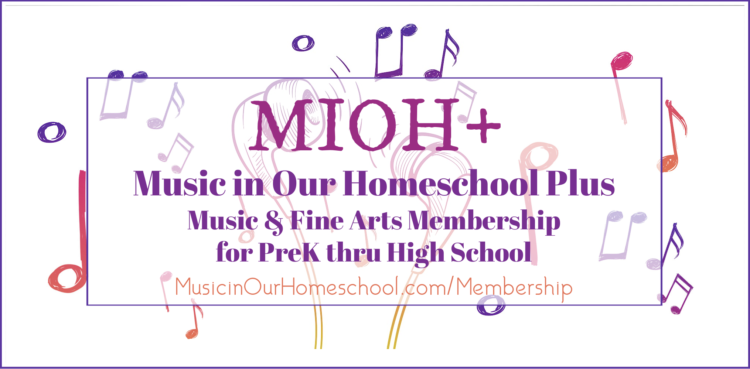Free 20th Century Music Appreciation Lesson: Sousa and Joplin

Today I'd like to share something that I've been working on this year and am happy to share some free 20th Century music appreciation lessons with you.
Music Appreciation at our Homeschool Co-op
My kids are now involved in a Tapestry of Grace Fellowship Group where they are studying 20th Century History and Literature, and I teach a 20th Century Music Appreciation class each week. I use the following lesson plan format for all ages Kindergarten through 12th grade, with the elementary kids in one class and upper grades in another. I teach more detail for the upper grades and add a coloring sheet (usually of an instrument that's being featured) to the lower grades. Another thing I do is have a blank form for the older kids to fill out while I'm teaching them, as well as a form for them to fill out while they are listening to the music. I'll be compiling all the lessons into an e-book to share at the end of the year. But, until then I'll be sharing some of the lessons with you!
Enjoy this lesson about Marches with John Philip Sousa and Ragtime with Scott Joplin!
You can download the PDF versions of the
- Sousa and Joplin Music Appreciation Lesson
- 20th Century Music History Notebooking Page
- 20th Century Music Listening Printable
[wp_eStore_free_download_squeeze_form id=16]
John Philip Sousa (1854-1932)
led the U.S. Marine Band from 1880-1892. Then he formed his own band and toured the United States and Europe for the next 40 years. He wrote some operettas, waltzes, and 136 marches. A march is a form usually played by a band (such as marching band) that is typically in 2/4 time. Hear two of his most popular marches “Stars and Stripes Forever”
and
“The Washington Post”
In the 1890’s the march form helped lead to the ragtime piano style. Marches emphasize beat one; whereas rags syncopate the beat and emphasize beat two. The most popular years for ragtime was from 1900-1925, and the most popular composer was Scott Joplin.
Scott Joplin (1868-1917)
started piano lessons as a boy but probably didn’t go to school until he was a teenager. He went to college at age 28 and published 50 compositions. He wrote some marches and then started writing ragtime piano music. When he published the “Maple Leaf Rag” in 1899, it became the first piece of sheet music to sell over 1 million copies.
Joplin said ragtime music shouldn’t be played fast. Here’s “The Pineapple Rag”
and
“The Entertainer”
https://www.youtube.com/watch?v=fPmruHc4S9Q
Composers such as George Gershwin and Irving Berlin (who wrote “Alexander’s Ragtime Band”) were influenced by ragtime music.
A style that grew out of ragtime was called “stride piano.” It’s more improvisational than ragtime. The right hand still plays the melody, but the left hand has more leaps. Pianists would play popular songs of the day in the stride style.
James P. Johnson (1891-1955)
is known as the “Father of Stride.” A famous piece of the era was “Carolina Shout”
“Fats” Waller (1904-1943)
was another popular stride performer and composer. He wrote the stride piano piece “Handful of Keys.”
An entire musical was written about Fats Waller using his music; it’s called Ain’t Misbehavin’, and here is “Handful of Keys” sung
Special Deal:
Get the entire 20th Century Music Appreciation self-paced online course at Learn.MusicinOurHomeschool.com. Use coupon code CHOOSEJOY to get $10 off!






This sounds like an amazing lesson. I love all the links to the videos you have shared as well. We haven’t really studied much of music, but I would love to see how my kids like this and go from there. Thanks for sharing this.
We are party of a homeschool Fellowship also and it has really enriched our homeschooling. I think for our family the key to a successful co-op situation is focusing on the curriculum we use. Our fellowship has added depth to both our studies and the relationships with those dear families. Blessings, Kyle
Oh I love this! What a great resource. Just pinned it to my music and composer board. Thanks for sharing it at the #laughlearnlinkup.
LOVE this lesson! (Though I was expecting Janis Joplin… maybe next time?)
That’s funny! Yes, I’ll do some pop/rock singer lessons later on in the year, so maybe I’ll include Janis Joplin there!
–Gena
Neat! Thanks for sharing!